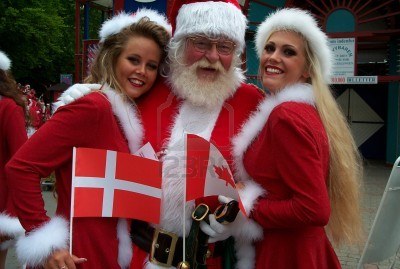
* This is the latest post in a weekly series, highlighting stories from my travel-writing archive. Subscribe to the RSS feed for more.
Want to read more like this? Try The Holy Grail of Hotdogs in Copenhagen.
It was the summer of 1968 and young people around the world were clambering for a social revolution. Meanwhile, in Billund, a remote corner of western Denmark, Godtfred Kirk Christiansen was starting his own social revolution – one involving brightly coloured plastic bricks.
For on June 7, 1968, Godtfred opened the doors of LEGOLAND for the first time.
LEGO is one of the world’s favourite toys with seven LEGO boxes now sold every second.
With LEGOLAND Billund celebrating its 40th anniversary this year, and the LEGO toy celebrating its 50th birthday, the park is planning a series of events over summer to mark these milestones.
There are three other LEGOLAND theme parks around the world, namely Windsor, UK, Günzburg, Germany and San Diego, California, while an option for a fifth park in the United States is currently under discussion.
LEGO origins
LEGO was founded in Denmark in 1932 when Ole Kirk Christiansen, a local carpenter, started making wooden toys. He named them LEGO, a contraction of the Danish ‘leg godt’, meaning ‘play well’.
He was unaware at the time that, coincidentally, the Latin meaning of the word is ‘I put together’.
Ole and his son Godtfred started manufacturing plastic bricks after the end of World War II. The first plastic bricks hit the market in 1949 and were named LEGO: Automatic Binding Bricks.
The company underwent exponential growth during the Fifties and Sixties with Godtfred’s children becoming international stars as they were featured playing with LEGO on the front cover of all the boxes. Godtfred had developed the brick design and wisely took out patents on four-tube brick.
He opened the Billund park to showcase his work.
Today LEGO is owned by Kjeld Kirk Christiansen, founder Ole’s grandson. LEGO has three manufacturing plants in Denmark, the Czech Republic and Mexico, and is on sale in over 130 different countries.
The 2,400 different LEGO brick shapes are produced under strict controls, whereby any brick not within a thousandth of a millimetre to the correct size is rejected, ensuring that all bricks can be firmly connected.
For an exclusive preview of the anniversary celebrations, I travel to the nondescript, small town of Billund, which is dominated by the sprawling grey-brick LEGO complex, to learn the secrets behind LEGO’s enduring popularity.
My base for the weekend is the LEGOLAND hotel, a comfortable but not luxurious place to stay with private access to LEGOLAND and family-friendly facilities.
The hotel caters for two distinct groups: families visiting the park and businessmen attending one of LEGO’s Business & Bricks team-building events.
With a captive audience, prices are accordingly high, but the hotel is a LEGO fan’s dream with striking LEGO models throughout – from a LEGO pianist in the bar to a giant LEGO Darth Vader standing guard over reception.
Hotel design
The standard rooms are functional but LEGO devotees will no doubt splash out on the 12 rooms themed around knights, princesses and pirates, which feature LEGO models, en-suite bathrooms and bunk beds for children.
At dinner that night, I chat with some of the other families staying at the hotel. Eight-year-old Kento had come all the way from Yokohama, Japan, to soak up the LEGO experience.
“We’re staying just two nights but it’s worth the journey as Kento loves his LEGO. He plays with it every day,” explains mother, Hiroko.
Closer to home, the Sturrock family, who hail from the East Midlands, are taking a long-weekend break with their two children James and Charles.
“I first came here when I was a little girl and I wanted to bring my boys back here to experience it for themselves,” says mother, Alison.
She adds: “I think they are the perfect age to enjoy the park as they’re now aged seven and nine.”
After a night in a pirate room with a LEGO parrot watching over my bed, I head out the next morning to explore the park.
Around the park
At 140,000m sq and featuring 58m bricks it’s a huge complex, divided into sections for different age groups, including Duplo Land for toddlers, LEGOREDO Town with its Wild West theme for pre teens and Adventure Land with its adventure playground for older kids. There are theme park rides, such as a log flume and racing cars, although most are suitable only for kids aged seven and up.
My favourite section is Miniland, featuring model village-style LEGO takes on famous sights from around the world.
Here a rural scene from Japan, replete with Mount Fuji in the background, has been build entirely from LEGO bricks. It sits, rather incongruously, between scale LEGO models of Bergen and Copenhagen’s Nyhaven district.
The towering model of Mount Rushmore, featuring the iconic image of four American presidents carved into the South Dakota hillside, is the park’s piece de resistance – it is constructed from over 1.5m LEGO bricks and has survived since 1974.
As the company expands, LEGO changes around 30 per cent of its product range each year and all LEGO employees must sign a confidentiality agreement when they join the company to keep secret the products under development in the labs.
“LEGO is all about playful learning. It is such a creative material. It appeals to all ages from Duplo for toddlers to Technic for teenagers,” explains Kurt Bolding Kristensen, Manager of Miniland Projects at LEGOLAND, as we grab a coffee in the hotel bar later that day.
“You can build with LEGO for hours. The only limit is your imagination.”
Behind the scenes
I end my visit with an exclusive, behind-the-scenes peak inside the LEGO Ideas House, a nondescript section of the present-day complex, built on the original house where Ole First invented LEGO.
Closed to the general public, this time-capsule exhibition is normally only open to LEGO employees. It houses early models, such as wooden monkeys on bikes, early packaging and black-and-white adverts from the 1950s.
I finish my tour following the development of LEGO through the ages and come face to face with a LEGO TECHNIC tractor set I remember my parents buying for me as a Christmas present when I was ten years old.
“Everyone played with LEGO as kids and, when they come to the exhibition and see their old toys, you see it in their eyes,” says Ideas House creator and LEGO historian Kirsten Stadelhofer.
“We may grow up but LEGO is something that we always carry with us in our hearts.”
* This story was first published in BMI Voyager magazine in 2008.
Have you got a LEGO story, or a favourite place in Denmark?
Post your comments below.




